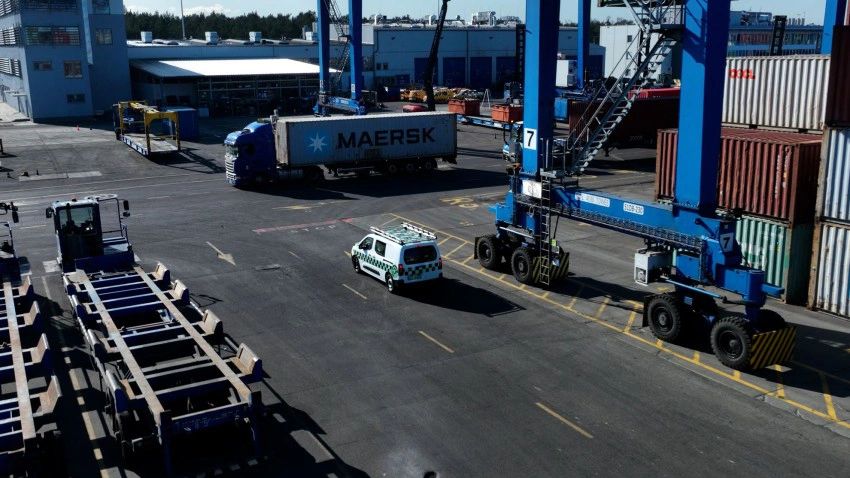
Maritime companies around the world are multiplying
their efforts to reduce greenhouse gas emissions into the atmosphere
from their operations. The largest container terminal in the Baltic
Sea, the Baltic Hub in Gdańsk, also follows this trend.
Shipping,
which accounts for the bulk of world trade and transport, has set
itself the task of significantly reducing greenhouse gas emissions,
and eventually even zeroing them. Shipyards and designers are
outdoing each other in inventing and commercializing newer and newer
solutions to make ships emission-free or at least more
energy-efficient. Shipowners around the world are trying to modernize
or replace their fleet. New pro-environmental investments are also
becoming the share of ports and sea terminals. Baltic Hub, the
largest container terminal in the Baltic Sea, has been implementing
projects to reduce its environmental impact for a long time.
– As an organization, we have
corporate emission reduction targets. By 2030, we intend to reduce
emissions by 50% compared to 2019, and we intend to be zero-emission
in 2050 – explains Dominika Milion, director of sustainable
development at Baltic Hub. As she says, the actions taken in the
terminal are divided into several groups.
It all starts with the smallest
things, such as giving up buying single-use plastic items or
installing bee hives on the roof of an administration building.
Baltic Hub also organizes campaigns involving employees, during which
it promotes activities for the environment by jointly collecting
electro-waste or cleaning up the world. Other events of this kind
include, for example, upcycling campaigns, in which the Baltic Hub,
among others, uses banners to create new backpacks or bags.
Compensation for protected species of birds during their breeding
season is also important.
The most technologically
spectacular, however, are investments in infrastructure and
superstructure.
– As part of its climate and
environmental protection activities, Baltic Hub is looking for new
technologies to replace conventional fuels used in terminal
equipment. This applies to both our tractors, vehicles working on the
yard, as well as overhead cranes – says Dominika Milion.
At the moment, a large part of the cranes in the Baltic Hub is already working thanks to electric motors. However, there are still devices that use diesel. Dominika Milion announces that they will be systematically modernized and will receive hybrid power to start reducing emissions before solutions that can completely eliminate them appear on the market. Of course, this does not apply to new equipment that will appear in a few years at the T3 terminal under construction – these will be electric from the beginning. What's more, they will also be equipped with photovoltaic panels that will provide the energy necessary for lighting and other functions.

Baltic Hub is also replacing the
fleet of passenger vehicles with electric cars. Green-marked Peugeot
and Kia cars started driving in terminal squares last year.
– In 2022, we replaced five
diesel cars with five low-emission, i.e. electric cars. This has so
far allowed us to reduce CO2 emissions by 2 tons – says Patryk
Pałkowski, coordinator for the car fleet at the terminal. – We are
planning further investments in zero-emission cars, we will gradually
replace internal combustion cars. In addition, we have installed the
first charging station for electric cars. More points will be built
in the future – Pałkowski assures.
Therefore, two electric Peugeots are already operating in the Baltic Hub, which can travel 230-240 km on a single charge. They are used by employees of the Operations Department and the Maintenance Department. Another three Kia cars with a slightly smaller battery but comparable range are shared by administrative departments for field work.
The most important means of
transport in the Baltic Hub, which in the near future will also use
electricity, are ships. The terminal is already preparing for the
implementation of onshore power supply, i.e. the possibility of
powering the ship's engines during a berth with energy from shore.
– Ships that come to us do not
work on the main engine when they are stationary, so they do not burn
heavy fuel, but they do use auxiliary engines, if only so that the
vessel has lighting or power supply for refrigerated containers. This
is where the emissions come from. There are plans for legal
regulations that will ensure that ships will be powered by shore-side
electricity when they are at a port, which is aimed at zeroing
emissions – says Dominika Milion.
However, for the use of electrical
devices to be truly low-emission, green energy is needed.
– We have been buying such green
energy for three years, but we have also started its own production.
So far, these are small-scale activities, because these are solar and
photovoltaic panels that are used to partially power buildings –
explains Dominika Milion, director of sustainable development.
Therefore, it is crucial to change
the national energy mix, which is to include more and more energy
from renewable sources in the coming years. However, the prospects
seem positive – the first offshore wind farm is to be launched in 4
years, and there are more onshore wind farms and photovoltaic
installations in the country. Everything indicates that when Poland
shifts to electricity from renewable sources to a greater extent, the
Baltic Hub infrastructure will be ready to use it optimally.


